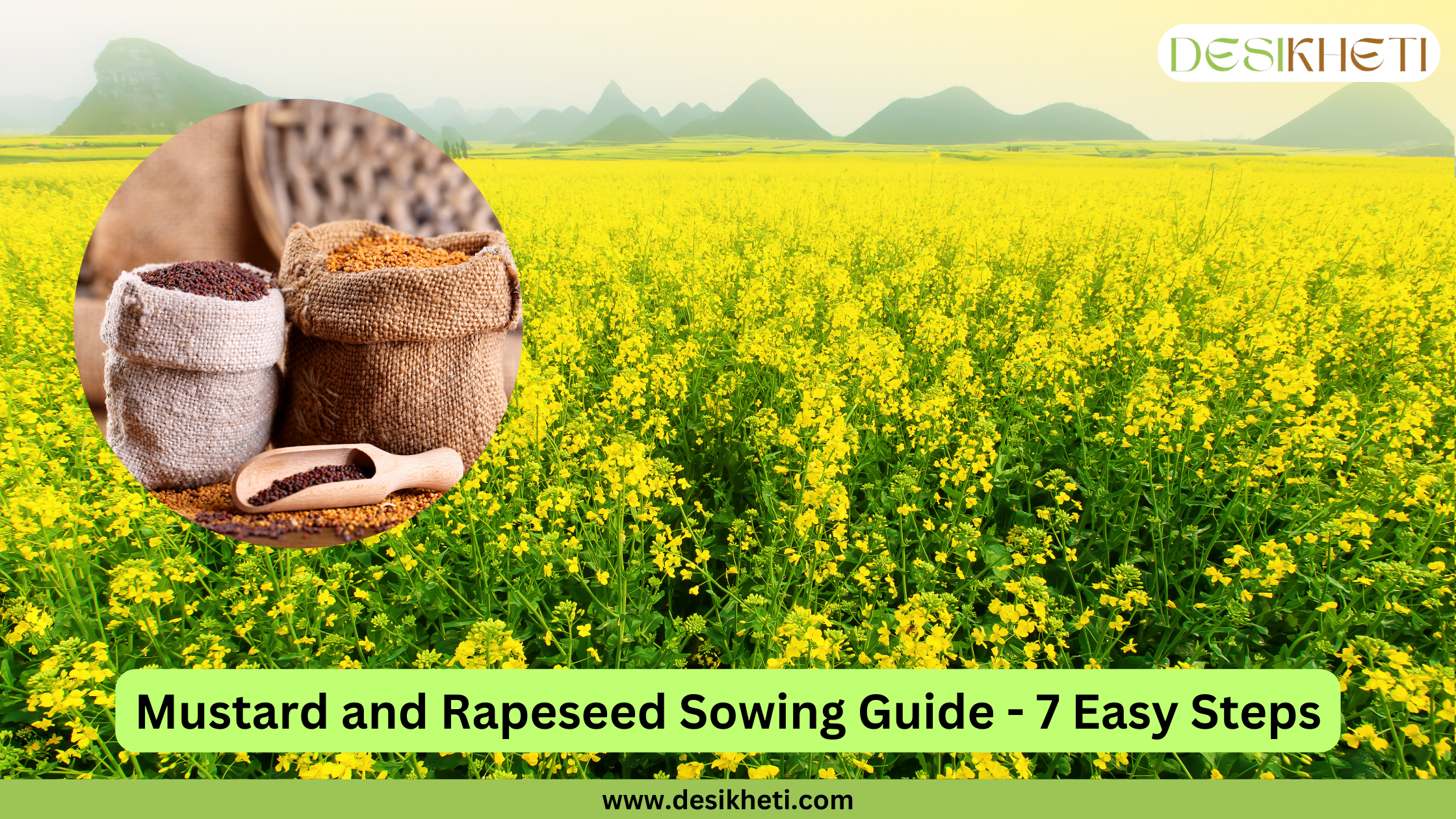Table of Contents
Introduction
Mustard & Rapeseed are among the most important rabi oilseed crops cultivated across India. Together, they account for a significant share of the country’s edible oil production, second only to groundnut. In common Indian language, sarson and toria refer to rapeseed (Brassica campestris var. sarson and toria), while rai refers to mustard (Brassica juncea).
Mustard & Rapeseed oil is used in cooking, hair oils, soaps, Ayurvedic medicines, and even for softening leather. Beyond oil extraction, these crops serve multiple purposes—they are used as condiments, in traditional medicine, and even consumed as leafy vegetables in their early stages due to their rich content of sulphur and minerals.
In this blog, you will discover simple and effective steps to sow Mustard & Rapeseed seeds.

Step 1: Climate, Soil, and Season for Sowing Mustard & Rapeseed Seeds
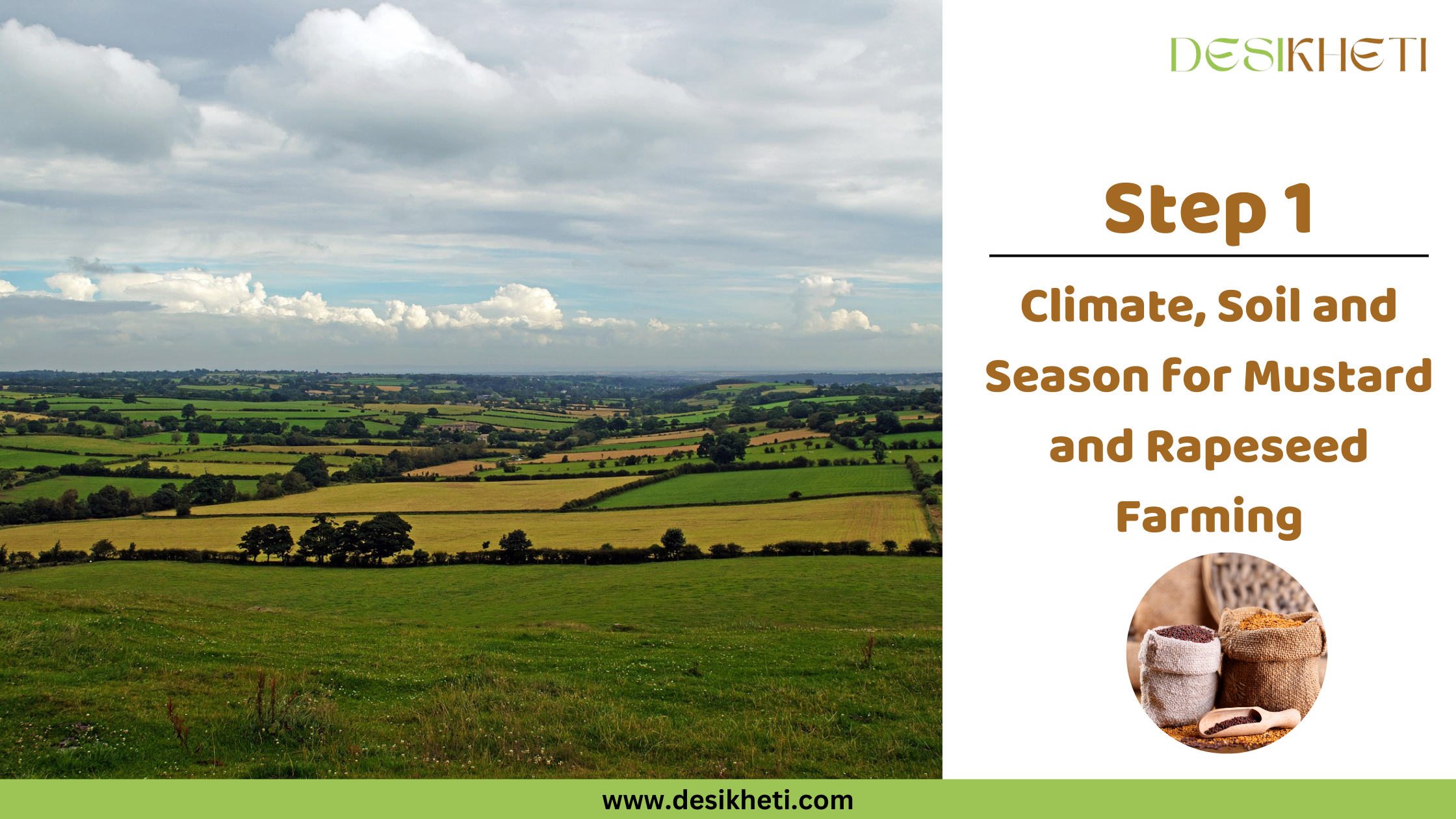
Climate for Mustard & Rapeseed Cultivation
Rapeseed and mustard are cool-season crops. They require relatively cool temperatures and a dry harvest period. Cool temperatures, clear dry weather with abundant sunshine, and adequate soil moisture can enhance yield. Temperatures between 24°C to 28°C are suitable for growth. Brassicas grow well in areas receiving 350–550 mm of rainfall.
Sarson is often grown in low-rainfall areas, whereas rai and toria are grown in medium- and high-rainfall regions, respectively.
Soil for Mustard & Rapeseed Cultivation
Rapeseed and mustard can be grown in a variety of soil types, including alluvial, medium loam, sandy loam, and heavy loam soils. Well-drained and fertile loamy soils support optimal growth and yield. Heavy clay soils that are prone to waterlogging should be avoided.
Season for Mustard & Rapeseed Cultivation
Rapeseed and mustard are cool-season crops mainly grown in North India during the rabi season, from September–October to February–March. Toria is more vulnerable to frost, so it may be sown earlier and harvested before the onset of frost to avoid damage.
Step 2: Selecting the Right Mustard & Rapeseed Variety
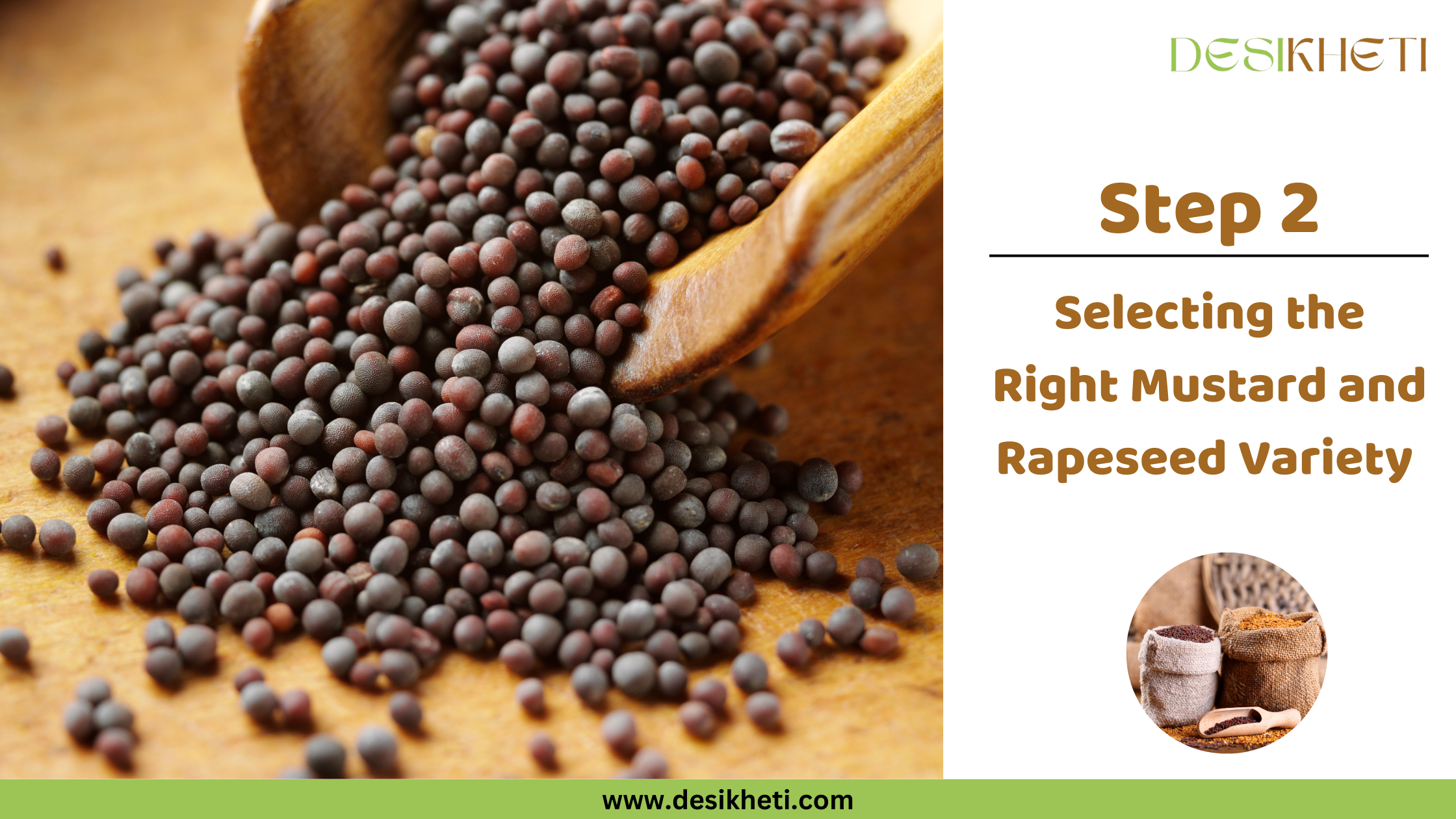
Various factors such as region, season, farming method, and seed color need to be considered while selecting a Mustard & Rapeseed variety. For your convenience, a few varieties are listed below.
Step 3: Procuring Quality Mustard & Rapeseed Seeds

For successful farming, selecting high-quality Mustard & Rapeseed seeds is essential. Even with the best cultivation practices, using poor-quality seeds may lead to low yields and weak plant health.
Looking for the best seeds? DesiKheti offers a wide range of premium seeds tailored to your farming needs. Browse our collection, place your order online, and enjoy fast, reliable delivery right to your doorstep.
Step 4: Land Preparation for Sowing Mustard & Rapeseed Seeds
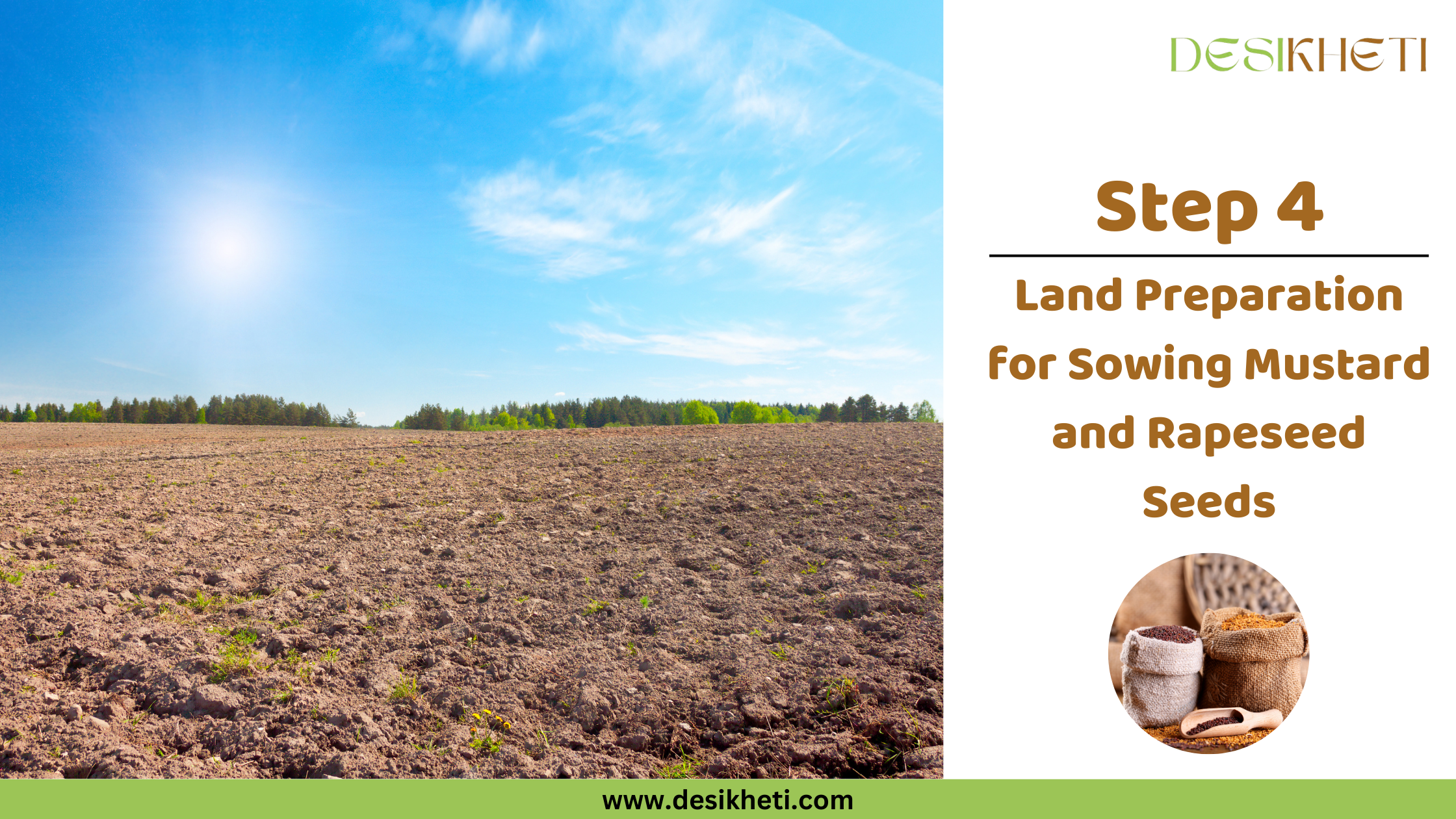
A well-prepared seedbed is important for good germination. In rainfed areas, where toria, brown sarson, or rai are grown after the kharif fallow, land preparation may begin during the monsoon rains.
The field can be deep ploughed using a soil-turning plough, followed by two cross cultivations to break the soil into a fine, levelled seedbed. Each ploughing may be followed by light rolling or planking so that the soil is finely pulverised and levelled.
It is beneficial to remove weeds and stubble to support healthy plant growth. During land preparation, 15 to 20 tons/ha of FYM (farmyard manure) may be added.

Step 5: Sowing Mustard & Rapeseed Seeds
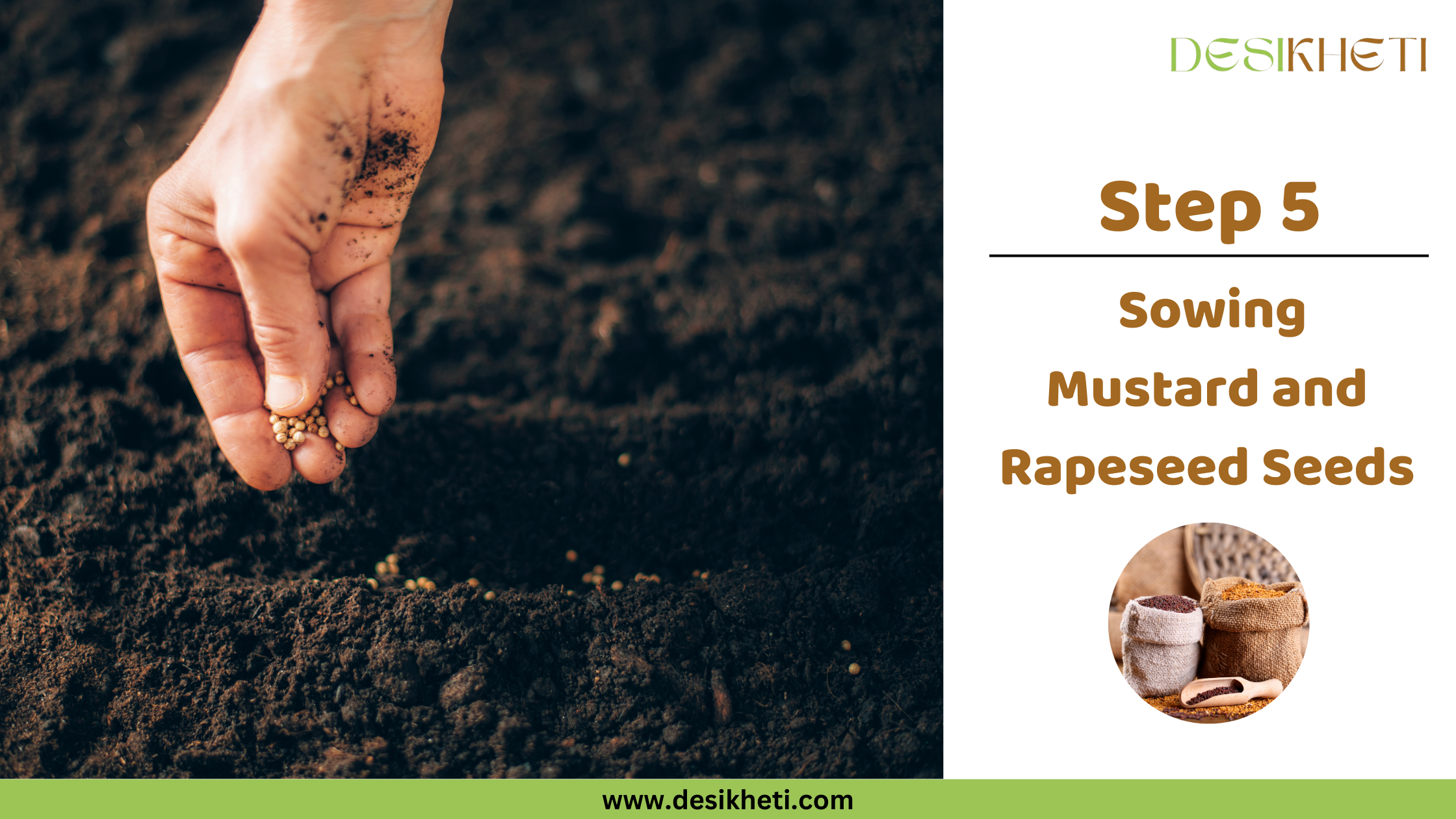
Seed Rate: Usually, 1 kg of seeds may be required per acre of land. However, the exact seed rate can vary depending on the variety, spacing, cultivation purpose, method of sowing, and other factors.
Seed Treatment: Seeds sold by the private sector are usually treated with chemicals before sale. However, if the seeds are not pre-treated, they can be treated with Carbendazim or Captan at 2 g per kg of seed.
Proper sowing time is one of the most important factors influencing the seed yield of rapeseed and mustard. The rate of oil development in seeds is greatly influenced by variations in atmospheric temperature, humidity, and other biotic factors. Therefore, sowing too early or too late can negatively impact yield.
Toria is usually sown in the first fortnight of September. If wheat is to follow, the crop may be sown by the end of August. Sarson is generally sown from the third week of September to the second week of October. Rai is typically sown from the second week of October to the second week of November.
Seeds can be sown either behind the plough or using a seed drill. The seeds may be mixed with an equal quantity of sand to ensure uniform distribution during sowing.
Seeds are usually sown at a depth of 3–4 cm. Generally, a row-to-row spacing of 30 to 45 cm and plant-to-plant spacing of 10 to 15 cm can be maintained. After 20–25 days, thinning should be done to maintain optimal spacing for healthy growth.
Step 6: Care After Sowing Mustard & Rapeseed Seeds

Water Management:
Rapeseed and mustard have low water requirements (450–600 mm) and usually thrive on residual monsoon moisture, especially in medium to heavy soils. However, providing two irrigations can be beneficial.
The first irrigation may be done during the flowering stage, as it can promote better branching, leading to increased flower and pod formation. The ideal time for the first irrigation is when flowering has sufficiently advanced. The second irrigation can be applied during the fruiting stage to support optimal seed development.
Weed Management:
The crop grows quickly and generally experiences minimal weed competition after establishment. However, during the early growth stages, weeds may reduce yield. Therefore, 2–3 weddings may be necessary. The first weeding can be done along with thinning, and the remaining ones at fortnightly intervals. One intercultivation about three weeks after sowing can also be helpful.
Step 7: Harvesting Mustard & Rapeseed

The crops mature at different times depending on the variety and sowing period. Toria can be ready for harvest in 80–100 days, rai in 110–180 days, yellow sarson in 130–160 days, and brown sarson in 105–145 days.
Harvesting is usually done when the leaves turn yellow but before the pods begin to split, to help prevent seed loss. Sarson is less prone to shattering, but in the case of mustard, care should be taken to harvest just before the pods open to avoid heavy losses from seed shattering. The plants may be uprooted or cut using sickles.
After harvesting, the crops can be stacked for 7–10 days to allow drying. Threshing may be done by beating the dried plants with sticks to separate the seeds. After threshing, the seeds can be dried for a few more days before storage to help maintain quality and prevent spoilage.

Common FAQs Related to Mustard & Rapeseed
Q. What climate is best for growing Mustard & Rapeseed?
A. Mustard & Rapeseed thrive in cool climates with clear, dry weather and plenty of sunshine. Temperatures between 24°C to 28°C are ideal for their growth.
Q. Which soil is best for growing Mustard & Rapeseed?
A. Well-drained, fertile loamy soils such as alluvial, sandy loam, and medium to heavy loam are best for growing Mustard & Rapeseed. Avoid heavy clay soils prone to waterlogging.
Q. What is the seed rate of Mustard & Rapeseed per acre?
A. The usual seed rate is around 1 kg per acre, although it may vary depending on variety, spacing, and sowing method.
Q. When can Mustard & Rapeseed be harvested?
A. Harvesting time varies by variety. Toria matures in 80–100 days, rai in 110–180 days, yellow sarson in 130–160 days, and brown sarson in 105–145 days.
Q. How deep can Mustard & Rapeseed be sown?
A. Mustard and rapeseed seeds are typically sown at a depth of 3–4 cm.
Q. What is the scientific name of Mustard & Rapeseed?
A. The scientific name of mustard is Brassica juncea, while rapeseed includes varieties like Brassica campestris var. sarson and toria.

Join DesiKheti Whatsapp Channel for regular updates, farming tips, and information on agriculture.
